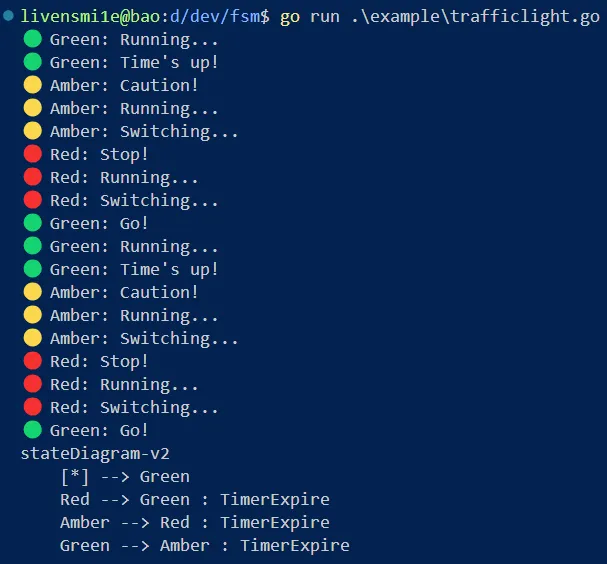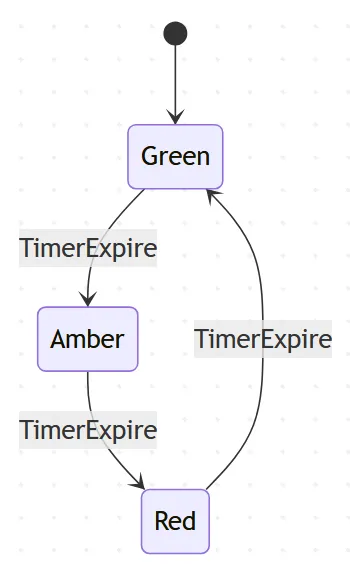Learn how to implement finite state machine
Finite state machine is an interesting concept, I learned long ago but only in theory. Now I have chance to actually explore how it can be implemented.
Table of Contents
Open Table of Contents
Ideate
I want to build fsm that can be:
- General - can be used in any usecase
- Support state, transition rule, trigger event and most importantly callback function
- Expose clean public API
- Later on, as I read blogs, I want it can be visualized on tools like drawio, mermaid,…
What I learned
This project is surprisingly short in time, I finished in just one day, not counting the idea day. The reason is there is one blog post that does most, very detailed, comprehensive and I just followed along.
I first need to imagine, try to understand how to design data structure for storing state and event. One common way is using map in go. But even using map, we also have more than one way to store it.
This is way for internal store.
type state struct {
transitions map[Event]State
}
type machine struct {
name string
current State
initial State
states map[State]state
err error
}This is way for intermediate, pre proccess store.
type Transition struct {
Event Event
Dst State
}
type Transitions []Transition
type StateConfig struct {
State State
Transitions Transitions
}
type States []StateConfigIt turns out that the latter is suitable for public API as it is straightforward.
To implement callbacks, instead of storing it in machines using map, we can let the state itself does that. Therefore, any state must implement these 3 methods.
type State interface {
OnEnter()
OnExit()
Execute()
}One drawback is that we have fixed number of callbacks, we cannot define more callback for more stimuslus, like if state A to state B, the callback X will be called, if state C to state B, callback Y will be called. But I accept this.
The most important logic here are:
func (m *machine) Transition(event Event) error {
if m.err != nil {
return m.err
}
next := m.getNextState(event)
m.current.OnExit()
m.current = next
m.current.OnEnter()
return nil
}
func (m *machine) getNextState(event Event) State {
if m.err != nil {
return nil
}
next, ok := m.states[m.current].transitions[event]
if !ok {
m.err = ErrEventDeclined
return nil
}
return next
}Also, I explore how to use builder pattern for nice, clean create function.
type MachineBuilder struct {
name string
initial State
states map[State]state
transMap map[State]map[Event]State
}
func NewMachineBuilder(name string) *MachineBuilder {
return &MachineBuilder{
name: name,
states: make(map[State]state),
transMap: make(map[State]map[Event]State),
}
}
func (b *MachineBuilder) SetInitial(initial State) *MachineBuilder {
b.initial = initial
return b
}
func (b *MachineBuilder) AddState(add State) *MachineBuilder {
b.states[add] = state{transitions: make(map[Event]State)}
return b
}
func (b *MachineBuilder) AddTransition(src State, event Event, dst State) *MachineBuilder {
if _, ok := b.transMap[src]; !ok {
b.transMap[src] = make(map[Event]State)
}
b.transMap[src][event] = dst
return b
}
func (b *MachineBuilder) Build() (Machine, error) {
if _, ok := b.states[b.initial]; !ok {
return nil, ErrInitialStateUndefined
}
for src, events := range b.transMap {
if _, ok := b.states[src]; !ok {
return nil, ErrStateUndefined
}
for event, dst := range events {
if _, ok := b.states[dst]; !ok {
return nil, ErrStateUndefined
}
b.states[src].transitions[event] = dst
}
}
return &machine{
name: b.name,
initial: b.initial,
current: b.initial,
states: b.states,
}, nil
}I also have serious time reading mermaid docs on state diagram.
Result
Voila, the machine works
 |  |
|---|